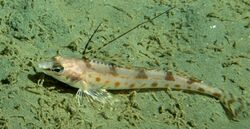Biology:Zaniolepis
| Zaniolepis Temporal range: Pleistocene to Present[1]
| |
|---|---|

| |
| Longspine Combfish (Z. latipinnis) | |
| Scientific classification | |
| Domain: | Eukaryota |
| Kingdom: | Animalia |
| Phylum: | Chordata |
| Class: | Actinopterygii |
| Order: | Scorpaeniformes |
| Superfamily: | Zaniolepidoidea Shinohara, 1994[4] |
| Family: | Zaniolepididae Jordan & Gilbert, 1883 |
| Subfamily: | Zaniolepidinae Jordan & Gilbert, 1883[2] |
| Genus: | Zaniolepis Girard, 1858 |
| Type species | |
| Zaniolepis latipinnis Girard, 1858[3]
| |
| Synonyms[3] | |
| |
Zaniolepis, the combfishes, is a genus of marine ray-finned fish, it is one of two genera in the family Zaniolepididae. These fishes are native to the eastern Pacific Ocean. Z. frenata that was a source of food to the Native American inhabitants of San Nicolas Island off the coast of southern California , United States during the Middle Holocene.[5]
Taxonomy
Zaniolepis was first proposed as a monospecific genus in 1858 by the French zoologist Charles Frédéric Girard when he described Z. longispinis from Fort Steilacoom on Puget Sound in Washington (state) .[6] This genus is one of two genera in the family Zaniolepidae, each of which is classified within a monotypic subfamily.[7] The subfamily Zaniolepinae, along with the Oxylebiinae, haves been classified as two subfamilies in the Hexagrammidae.[4]
Etymology
Zaniolepis is a combination of xanion, which is a Greek word for a comb used to card wool, and lepis, meaning "scale", referring to the overlapping, almost ctenoid scales of Z. latipinnis.[8]
Species
The currently recognized species in this genus are:[9]
| Image | Scientific name | Common Name | Distribution |
|---|---|---|---|
| Zaniolepis frenata C. H. Eigenmann & R. S. Eigenmann, 1889 | shortspine combfish | Pacific Ocean southern Oregon, USA to central Baja California, Mexico. | |
 |
Zaniolepis latipinnis Girard, 1858 | longspine combfish | northeast Pacific Ocean |
Characteristics
Zaniolepis combfishes have a deep incision in the rear third their dorsal fin and the first 3 spines in the dorsal fin are highly elongated, extremely so in Z. latipinnis. The anal fin contains 3 spines while the first 2 rays in the pelvic fins are long and robust and extend past the origin of the anal fin. The caudal fin truncated.[7] These fishes reach a amximum length of 25 cm (9.8 in).[9]
Distribution and habitat
Zaniolepis combfishes are found in the eastern North Pacific Ocean from Alaska to Baja California. They are benthic fishes.[9]
References
- ↑ Sepkoski, Jack (2002). "A compendium of fossil marine animal genera". Bulletins of American Paleontology 364: 560. http://strata.ummp.lsa.umich.edu/jack/showgenera.php?taxon=611&rank=class. Retrieved 2009-02-27.
- ↑ Richard van der Laan; William N. Eschmeyer; Ronald Fricke (2014). "Family-group names of Recent fishes". Zootaxa 3882 (2): 001–230. doi:10.11646/zootaxa.3882.1.1. PMID 25543675. https://www.researchgate.net/publication/268078514.
- ↑ 3.0 3.1 Eschmeyer, William N.; Fricke, Ron; van der Laan, Richard, eds. "Genera in the family Zaniolepididae". California Academy of Sciences. http://researcharchive.calacademy.org/research/ichthyology/catalog/fishcatget.asp?tbl=genus&family=Zaniolepididae.
- ↑ 4.0 4.1 Catherine W. Mecklenburg; William N. Eschmeyer (2003). "Family Hexagrammidae Gill 1889 Greenlings". California Academy of Sciences Annotated Checklists of Fishes 2. https://www.calacademy.org/sites/default/files/assets/docs/hexagrammidae.pdf.
- ↑ Vellanoweth, R. L. & Erlandson, J. M. (1999): Middle Holocene Fishing and Maritime Adaptations at CA-SNI-161, San Nicolas Island, California. Journal of California and Great Basin Anthropology, 21(2): pp. 257-274
- ↑ Eschmeyer, William N.; Fricke, Ron; van der Laan, Richard, eds. "Species in the genus Zaniolepis". California Academy of Sciences. http://researcharchive.calacademy.org/research/ichthyology/catalog/fishcatget.asp?tbl=species&genus=Zaniolepis.
- ↑ 7.0 7.1 J. S. Nelson; T. C. Grande; M. V. H. Wilson (2016). Fishes of the World (5th ed.). Wiley. pp. 467–495. ISBN 978-1-118-34233-6. https://sites.google.com/site/fotw5th/.
- ↑ Christopher Scharpf; Kenneth J. Lazara, eds (11 July 2021). "Order Perciformes: Suborder Cottoidea: Infraorder Zaniolepidoales: Family Zaniolepidae". The ETYFish Project Fish Name Etymology Database. Christopher Scharpf and Kenneth J. Lazara. https://etyfish.org/perciformes17/.
- ↑ 9.0 9.1 9.2 Froese, Rainer and Pauly, Daniel, eds. (2022). Species of Zaniolepis in FishBase. August 2022 version.
Wikidata ☰ Q425791 entry
 |

